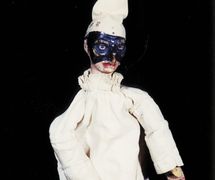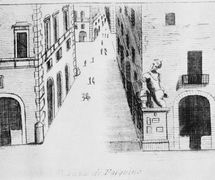Italian puppeteer. Ghetanaccio is mainly known from contemporary accounts and pictorial references, including those of the painter, engraver and sculptor Bartolomeo Pinelli (1781-1835). This strolling performer wandered through Rome with his casotto, a collapsible booth which he always carried with him and which he could set up anywhere to give shows.
Ghetanaccio was a solo performer and he managed to operate several puppets at the same time and produce a multitude of voices. The figure that best suited his independent and nonchalant character was Rugantino, a “mask” (maschera, stock character) that he invented, but who is clearly related to the braggart captains of the commedia dell’arte. Rugantino’s character corresponded closely to that of the popular classes of Rome, intolerant of authority, always ready to quarrel, but incapable of any action demanding true courage. His name is derived from ruganza (arrogance), and the character became synonymous with a boastful (vantone) and straight-speaking Roman. The poet Giuseppe Gioacchino Belli (1791-1863), who painted a fresco of papal Rome in his sonnets, evoked Rugantino and his bragging.
Dressed as a gendarme in trousers, waistcoat, a red tail-coat in the French style, shoes with buckles and a high hat, he was a caricature of a pontifical policeman. When, later, he dressed in civvies he exchanged his status as a puppet for that of an actor, a rare example of a case of a puppet giving birth to a flesh and blood actor rather than the reverse. In this latter guise, Rugantino was played by famous Italian actors.
Pulcinella was one of Ghetanaccio’s other favourite characters; a precious example is kept in the Maria Signorelli collection. Ghetanaccio made him speak using a pivetta or swazzle such as was used by Neapolitan puppeteers for Pulcinella when this “mask” did not use Neapolitan dialect, and this gave a guttural whistling sound to his voice. Pulcinella was surrounded by all his children, the Pulcinelletti, who appealed particularly to the Roman populace.
Like Rugantino, Pulcinella did not like to submit to authority and consequently in papal Rome Ghetanaccio often ended up in prison. After Pope Leo XII banned theatrical shows during the holy year of 1825 and, for moral and religious reasons, did so on many other occasions in ordinary years, Ghetanaccio had to give up his itinerant activity. He died a few years later, in poverty and forgotten.
His character of Rugantino survived, giving his name to newspapers, magazines, theatrical scripts, one of the most important of which was a scenario for puppets by the writer and thinker Giovanni Giraud (1776-1834), now in the Biblioteca Casanatense in Rome, under the title Malvinuccia ossia la bambina di 4 anni supposta sposa del Signor Cassandro (Malvinuccia, or the Little Girl of Four, Supposedly the Wife of Signor Cassandro, 1832), in which one of the characters is precisely Rugantino.
(See Italy.)
Bibliography
- Bragaglia, Anton Giulio. Le maschere romane [Roman Masks]. Roma, 1947.
- Chiappini, Filippo. Il volgo di Roma [The Populace of Rome]. Roma: Loescher, 1890.
- McCormick, John, with Alfonso Cipolla and Alessandro Napoli. The Italian Puppet Theater – A History. Jefferson (NC): McFarland & Co., 2010. (See chapter on puppets and the Commedia dell’Arte.)
- Morelli, Marino. Fanfulla della domenica. 5 May 1895.
- Signorelli, Maria. Ghetanaccio. Padua: Amicucci, 1960.
















